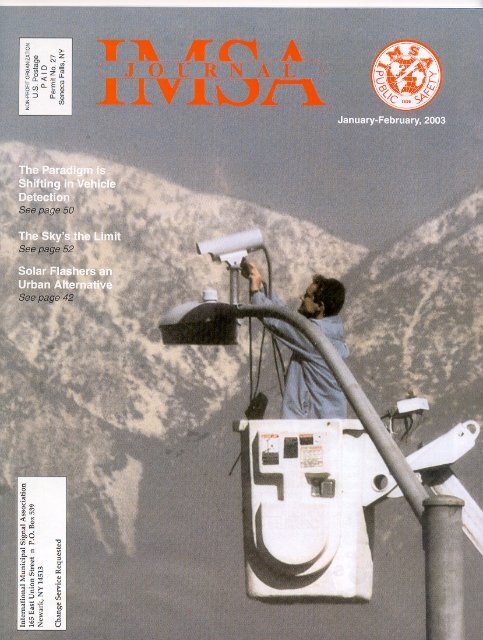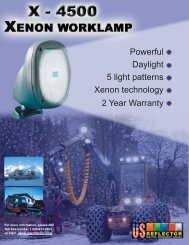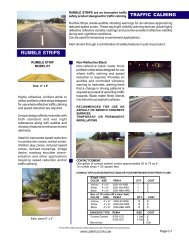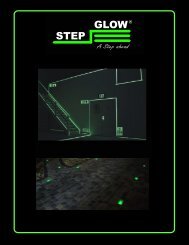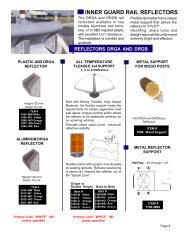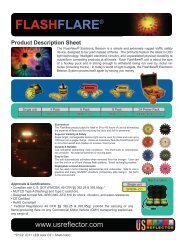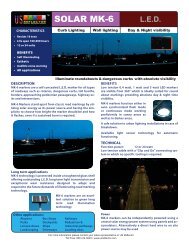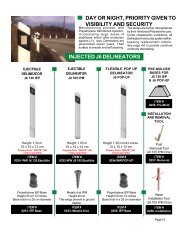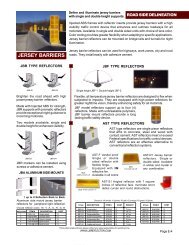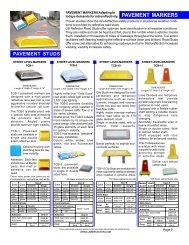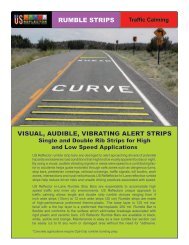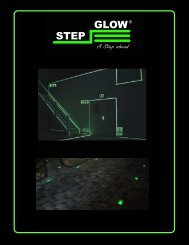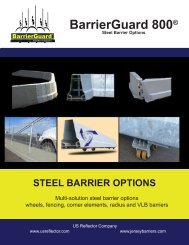Ware image page.p65 - US Reflector
Ware image page.p65 - US Reflector
Ware image page.p65 - US Reflector
- No tags were found...
Create successful ePaper yourself
Turn your PDF publications into a flip-book with our unique Google optimized e-Paper software.
360 O CURB MARKERS<br />
Inspired from its creator…Vehicle aspherical head lamps,<br />
Optical Curb Markers reflect the next generation of street markings<br />
Over 100 years ago, a new industry of glass production<br />
was born. This industry would create flat glass and soon<br />
offer new ways in projecting and modifying light beams as it<br />
passes through preformed glass.<br />
A<br />
Andre Blondel, the founder of Glass Works in France<br />
pioneered and revolutionized the glass industry by<br />
exploiting its patents in the field of lighting.<br />
B<br />
1925, the automobile industry was developed replacing flat<br />
glass with prismatic lenses. Due to the demand and growth<br />
of the auto industry, the manufacturing of glass head lamps<br />
began.<br />
In 1965, the first head lamp lenses were produced utilizing an automatic pressing system. 30 years<br />
later the glass lens industry would soon be jeopardized by new age plastics producing plastic<br />
headlight protective lenses in place of glass. This unforeseen change caused glass manufactures<br />
around the world to close their doors. In fact, one of the founding glass works in France would soon<br />
face the same unpredictable consequences of industry change.<br />
History, experience, technology and a new vision would be the only supporting strength for any<br />
company to fight, transform and adapt to today’s demands were specifications and regulations restrict<br />
the creative mind from exploiting there full potential.<br />
C<br />
A. Bosch 1920’s<br />
B. Prismatic 1970’s<br />
C. Aspherical light<br />
combinations 2000<br />
Technology has unveiled its capabilities of producing products that are compact, lightweight, efficient and cost effective such as<br />
the computer industry. Technology has also had its impact in the glass industry by providing new grounds for development.<br />
This development is the new aspherical lenses and modules that will illuminate the new century with ultra performing<br />
light projection systems that will ultimately change the way we see the road ahead.<br />
Plastic protective lens<br />
Discrete, compact, lightweight, high-tech aspherical lenses<br />
are a true breakthrough for the automotive industry.<br />
The new design is capable of reducing the cost of<br />
High beam<br />
front-end lighting systems by 20% while providing<br />
headlights with the ability to project light similar to clarity<br />
of daylight.<br />
Aspherical lenses are built with state of the art equipment<br />
but have had a tendency to project strict ridged light<br />
beams until recently.<br />
The Engineers at the glass works (Holophane France) have<br />
learned to change textures within the glass manufacturing process.<br />
This process in conjunction with 100 years of glass production now<br />
Aspherical lens<br />
allows vehicle headlight lenses to project a smooth gradient white<br />
light for improved nighttime visibility. This light is produced by a gas discharge system called Xenon. Xenon lamps in<br />
conjunction with the aspherical projection lens provides amazing characteristics allowing vehicle headlights to produce<br />
light so bright and clear it is almost equal to daylight.<br />
How does this effect roadside delineation<br />
The optical light beams projected from its aspherical lens provides a superior ground driving light that is much more<br />
comfortable and less irritating on the eyes. If compared to traditional automotive headlights, aspherical lenses meet the<br />
exact demands of SAE specifications were as traditional light systems have a more “scattered” light projection that<br />
appears to provide more overhead light but in no way can compete with the quality of an aspherical head lamp.<br />
During the next year, we will be investigating the possibilities of altering low beam overhead light<br />
projection to enhance the visibility of roadside and overhead signalization better then ever. This can<br />
now be achieved through the advanced engineering of the aspherical lenses and modules in a<br />
matter of days when compared to the complex light reflex patterns of traditional reflective lenses.<br />
Next generation aspherical lenses.<br />
Page 58<br />
Continued on <strong>page</strong> 59<br />
IMSA Journal
Optical curb and pavement marker technology with<br />
TOTAL LIGHT FUNCTIONING<br />
The altering of glass and textures has provided new grounds of development, this development has gone beyond aspherical<br />
light projection and modernized itself into a Total Light Functioning system with 360 degree visibility that requires no<br />
electricity.<br />
Optical markers illuminate rotaries, curbs, winding roadways, intersections and many other<br />
applications were only an electric powered light would or could take its place. Optical Curb<br />
Markers provide a distinct crisp optical light signal that will follow a vehicles approach and<br />
passing as the eyes of the Mona Lisa follows its admiring onlookers.<br />
360 Degree Curb and pavement markers provide a sustained light reflection during the<br />
passing of a vehicle. Sustained light allows drivers will never fall out of its visible entrance<br />
angle as long as the marker is receiving light. This compact 2” x 2” marker will define and<br />
outline roadside curbs, medians, bull noses while eliminating shadowing from urban lighting.<br />
Roadways equiped with curb markers provide safer driving environments for all motorists<br />
especially during dark rainy conditions.<br />
As history has Portrayed, great achievements sometimes happen by accident, in this particular<br />
case, the founder of the curb marker Daniel Bemer, had his accident while driving home.<br />
Daniel, formerly director of production at the glass works in France was driving home on a dark rainy night. During his trip<br />
home, he came upon a truck traveling in the same direction. As in most situations, Daniel turned on his left signal and<br />
passed the truck. As he was passing the truck, his vehicle received a massive impact from underneath almost loosing<br />
control, the truck driver saw that Daniel had hit a median centered in the road and began to slow down allowing Daniel to<br />
merge right eliminating a fatal crash into an upcoming median wall.<br />
A life changing experience, Daniel set out to find a way curbs could be illuminated.<br />
At this time, Holophane France was benefiting its climb back into the headlight industry with its new aspherical lens. Sales<br />
and growth allowed Daniel to step away from production and create a new division in traffic signalization at the glass works.<br />
His goal was to find a safe and efficient way of marking curbs.<br />
Before the curb marker was conceived, the idea of creating a reflective curb stone made entirely of reflective hardened<br />
glass was on the drawing board. The weak bonding of pavement / concrete to glass would not assure the glass curbs fixed<br />
position, especially if run over by trucks or heavy equipment which would eventually shift the curbs fixed position.<br />
Although manageable and functional in its own way, the glass curb was not the solution for the traffic industry. Daniel<br />
continued to research optics from as far back as early 1920’s hoping to find a way to build his vision. He came across a<br />
patent that ultimately sparked an alternative approach to achieving the conception of the Curb Marker.<br />
With no time to waste, Daniel installed a computer at home with specialized software to calculate optics. After several days<br />
and numerous calculations, he finally achieved what seemed to be the optical structure of the to be curb marker. With a<br />
solid mathematical plan of construction, Holophane glass works produced a prototype for testing. Daniel’s design would<br />
allow the curb marker to function between 0 to 20 degree if positioned on a slanted curb. After laboratory testing, the optical<br />
engineers contacted Daniel and told him his marker did not work 0 to 20 degrees but 0 to 40 degrees! The Opti-curb marker<br />
was a success!<br />
Soon the marker was refined and fitted<br />
with a rubber grommet to protect and<br />
support the marker while seated in the<br />
curb. This method of application would<br />
eliminate the use of adhesives. 1 year<br />
later new age 360 and 180 degree pavement<br />
markers were developed and<br />
added to the line.<br />
Opti-CURB’s smooth surface allows it to be self-cleaning.<br />
Mechanical properties provide outstanding strength, durability and<br />
wear resistance when compared to plastic marker systems.<br />
Installation<br />
Maintenance free<br />
Optical studs<br />
Utilizing a diamond drilling core designed specifically for curb markers and<br />
built by HILTI enables Opti-curb studs to be installed in under 2 minutes or<br />
250 studs per day with two men.<br />
Article by:<br />
George Cancelmo<br />
For more information,<br />
please contact George<br />
at 1-800-414-5024<br />
508-753-6373, by fax<br />
508-753-2142, or by e-<br />
mail at:<br />
george@usreflector.com<br />
January / February 03<br />
Page 59


